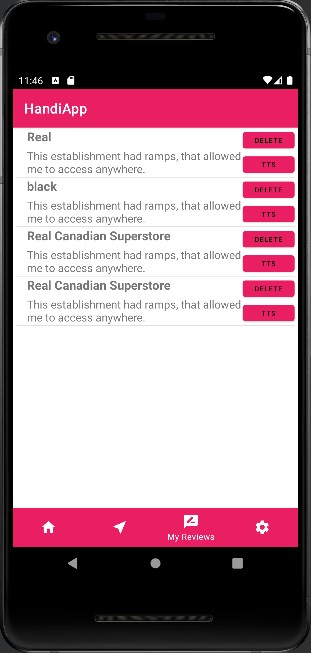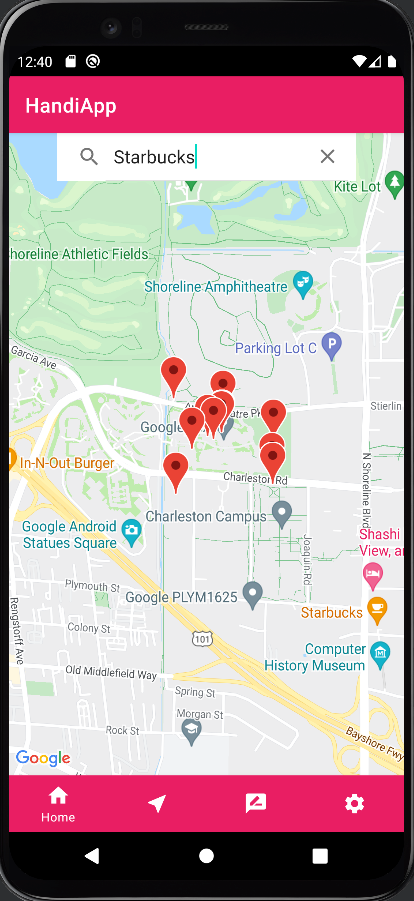Project Category: Entrepreneurial
Join our presentation
About our project
Individuals with physical or even visual impairments often find themselves frustrated at the few options available to get around certain establishments. Unable to find automatic doors, elevators, or even railing to ease the process of entering a nearby building can cause one to feel unwelcome. What if there was a way to know such information prior to visiting a location?
That’s simply what HandiApp strives to do.
HandiApp is a crowdsourced, centralized mobile application to find all sorts of information regarding accessibility options within an establishment. Users can simply post reviews associated with buildings of choice within certain categories for others to view. Once posted, those who wish to know more about where they will be visiting next can simply view other users’ reviews to find out whether it’s worth the trip or not.
Meet our team members
Tyler Shenassa
Saadat Darwish
Mehdi Marzban
Jonathan Lui
Bikramjeet Singh Atwal
Details about our design
HOW OUR DESIGN ADDRESSES PRACTICAL ISSUES
When visiting a new location, people tend to conduct some research on the establishment. This is mostly done through reading a catalog of reviews associated with that establishment. If a restaurant, reviews tend to describe how good the food was or whether the price was right but never include any information regarding how easy it was to get to your seat or whether the bathroom was accessibility friendly. Our application strives to conveniently allow our users to find such information in the form of a review. This can save people time and energy as they can know whether the trip is worth it prior to visiting, like one would do when deciding what to eat.
WHAT MAKES OUR DESIGN INNOVATIVE
When trying to get information regarding accessibility options, it becomes very difficult to find anything online. After scouring the internet for hours rummaging through countless reviews you may find a few points that can explain what you are walking into. This becomes a tedious process as those with accessibility needs don’t have the luxury to just visit any location and expect their needs to be fulfilled. HandiApp aims to make such individuals’ lives easier and allow for them to easily find the information they are looking for.
WHAT MAKES OUR DESIGN SOLUTION EFFECTIVE
Our design solution’s crowdsourced data gathering methodology allows for an effective way to attain the accessibility options that are available at establishments. Establishments themselves can input what accessibility they have available at specific locations, providing optimal knowledge. In addition to crowdsourcing, the convenience of putting it all into a mobile application makes it easier to utilize for the general public. We believe a broader scope of impact that the application provides is that it can become a standard that establishments follow. For example, if a restaurant is lacking in wheelchair support, the HandiApp users could address it and as a result the restaurant can see that it is a known issue and make attempts to implement a proper solution. All in all, we see that the HandiApp is a unique solution in a niche environment and that it can be very effective in providing its users the information they need regarding accessibility options.
HOW WE VALIDATED OUR DESIGN SOLUTION
When working on the project, our team mainly used android studio to develop the application. Using the IDE, our team was able to continuously test any new updates simply by simulating an android phone and running the application. As a large portion of our application is reliant on our data stored within our database, a large aspect of testing was to conduct tests on our endpoint requests.
Furthermore, simple unit tests were conducted to prevent bugs for user inputs such as testing whether an email is valid or not.
FEASIBILITY OF OUR DESIGN SOLUTION
Our project was developed with the help of Amazon Web Services, Google play store, Google Adsense, and Google Maps Api. Utilizing these various platforms made development of the application very cheap, most of these platforms are easily scalable along with the application, only additional fees would be needed to support the increased user base. The main cost of the project comes from marketing using google ads, and as sizes increase then the costs to support the databases and servers would have to increase with it as well.
Partners and mentors
We want to thank the many people who helped us with this project. We received support from our technical academic advisor (TAA), our technical teaching assistant (TTA), and our business teaching assistant (BTA).
TAA – Desmond Larsen-Rosner
TTA – Manuel Zamudio Lopez
BTA – Cole Thiessen
Our photo gallery



